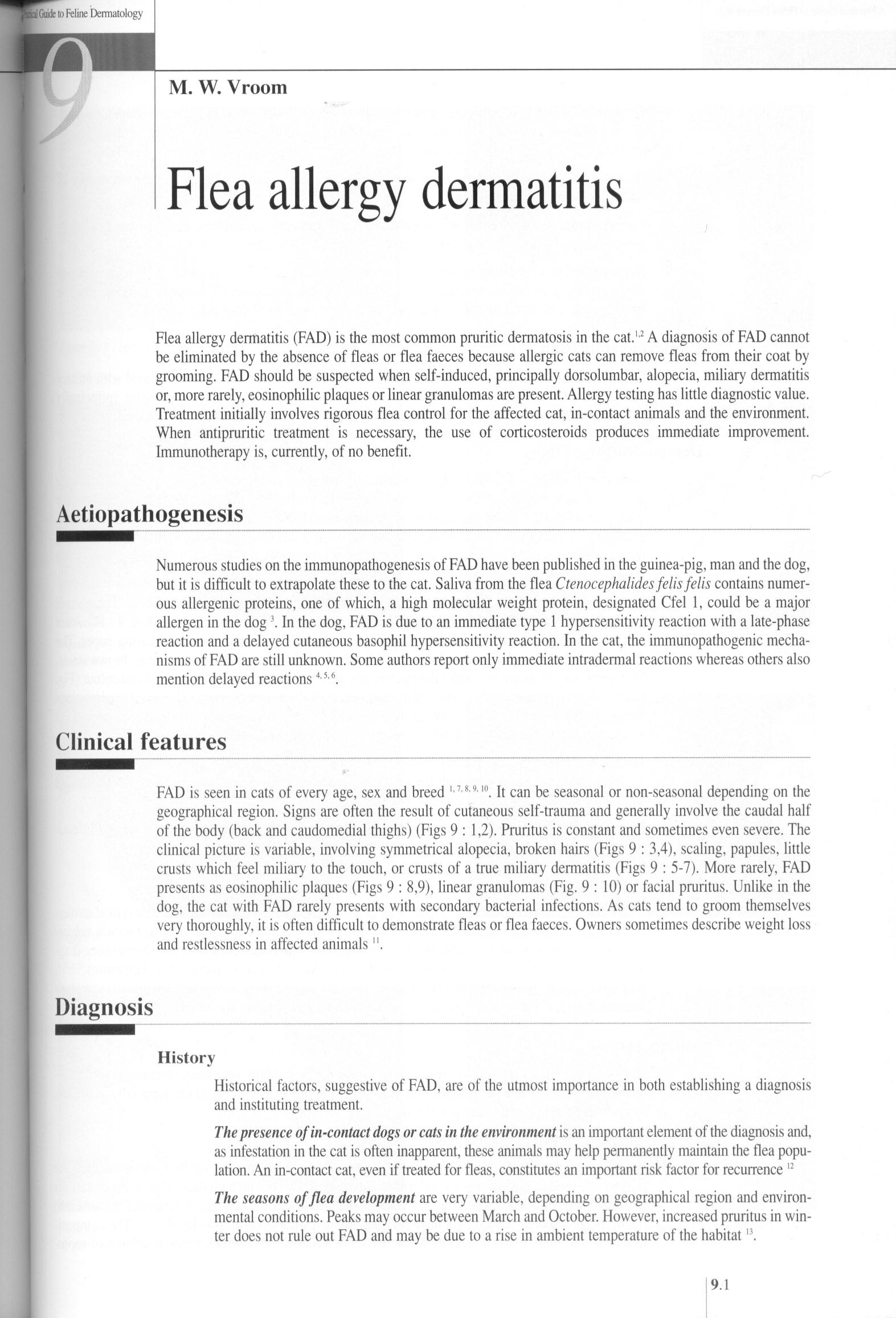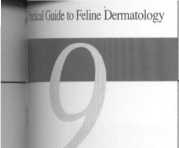91 (103)


M. W. Yroom
Flea allergy dermatitis
Flea allergy dermatitis (FAD) is the most common pruritic dermatosis in the cat.1,2 A diagnosis of FAD cannot be eliminated by the absence of fleas or flea faeces because allergic cats can remove fleas from their coat by grooming. FAD should be suspected when self-induced, principally dorsolumbar, alopecia, miliary dermatitis or, morę rarely, eosinophilic plaąues or linear granulomas are present. Allergy testing has little diagnostic value. Treatment initially involves rigorous flea control for the affected cat, in-contact animals and the environment. When antipruritic treatment is necessary, the use of corticosteroids produces immediate improvement. Immunotherapy is, currently, of no benefit.
Aetiopathogenesis
Numerous studies on the immunopathogenesis of FAD have been published in the guinea-pig, man and the dog, but it is difficult to extrapolate these to the cat. Saliva from the flea Ctenocephalides felis felis contains numerous allergenic proteins, one of which, a high molecular weight protein, designated Cfel 1, could be a major allergen in the dog \ In the dog, FAD is due to an immediate type 1 hypersensitivity reaction with a late-phase reaction and a delayed cutaneous basophil hypersensitivity reaction. In the cat, the immunopathogenic mecha-nisms of FAD are still unknown. Some authors report only immediate intradermal reactions whereas others also mention delayed reactions4 5,6.
Clinical features
FAD is seen in cats of every age, sex and breed 17 8 910. It can be seasonal or non-seasonal depending on the geographical region. Signs are often the result of cutaneous self-trauma and generally involve the caudal half of the body (back and caudomedial thighs) (Figs 9 : 1,2). Pruritus is constant and sometimes even severe. The clinical picture is variable, involving symmetrical alopecia, broken hairs (Figs 9 : 3,4), scaling, papules, little crusts which feel miliary to the touch, or crusts of a true miliary dermatitis (Figs 9 : 5-7). Morę rarely, FAD presents as eosinophilic plaąues (Figs 9 : 8,9), linear granulomas (Fig. 9 : 10) or facial pruritus. Unlike in the dog, the cat with FAD rarely presents with secondary bacterial infections. As cats tend to groom themselves very thoroughly, it is often difficult to demonstrate fleas or flea faeces. Owners sometimes describe weight loss and restlessness in affected animals ".
Diagnosis
History
Historical factors, suggestive of FAD, are of the utmost importance in both establishing a diagnosis and instituting treatment.
The presence of in-contact dogs or cats in the emironment is an important element of the diagnosis and, as infestation in the cat is often inapparent, these animals may help permanently maintain the flea popu-lation. An in-contact cat, even if treated for fleas, constitutes an important risk factor for recurrence 12
The seasons of flea development are very variable, depending on geographical region and environ-mental conditions. Peaks may occur between March and October. However, increased pruritus in Winter does not rule out FAD and may be due to a rise in ambient temperaturę of the habitatl3.
9.1
Wyszukiwarka
Podobne podstrony:
45 (221) Figurę4:9:Generalisedexfoliative dermatitis in a Persian cat with dermatophytosis caused by
49 (197) 4: Dermatophytosis Ketoconazole is a fungicidal azole drug, used in the treatment of dermat
4 (1321) ■ 10 Atopic dermatitis Pascal Prelaud - Sophie Gilbert Atopy is the cause of many pruritic
P1240404 (2) 184 t. TT. S. 62. 85. 91. 103. mapa 44. tabl. 21*2, 5. 42*8* O 1 <
81111 skanuj0121 (6) M(> 1 atMms i.ilcoti 10. 26. 27. <10. -II. -I(>. 52. 58. 66. 85 S-l. 9
00092 ?546ec4ad45fd72a0b658e111513581 91 A Very Simple Set of Process Control Rules Figurę 2 shows
103 Polish Phoneme Statistics Obtained on Large Set of Written Texts Table 2 Most common Polish
91 Nowa ekonomia instytucjonalna a zmiany paradygmatu rozwoju gospodarczego World Bank, The Worldwid
12POLITICAL JPRS-EER-91-053 25 April 1991 members of its National Council. The brief report pre-sent
JPRS-EER-91-053 25 April 1991POLITICAL 17 Government madę payments to the Hungarian State because pr
103 Poland of static penetratlon are glven* Owlng to the llmlted use in Poland of statlo pe-netromet
1 01 boot bmp Microsoft Windows Uersion 1.91 Copyright (c) Microsoft Corporation, 1985. Ali Riyłits
93 (100) 9 : Flea allergy dermatitis Figurę 9:1: Self-induced dorsolumbar alopecia in a Persian cal
95 (100) 9 : Flea allergy dermatitis Figurę 9:9: Extensive eosinophilic plaques in a cat with FAD Fi
73 (103) 7 : Viral dermatoses Figurę 7:1: Ulcerative lesions on the upper and lower lip ofa cat with
więcej podobnych podstron